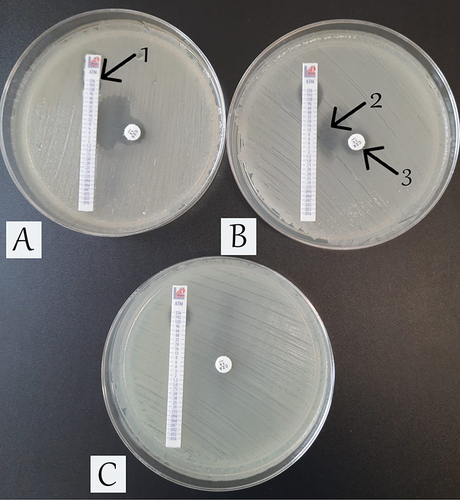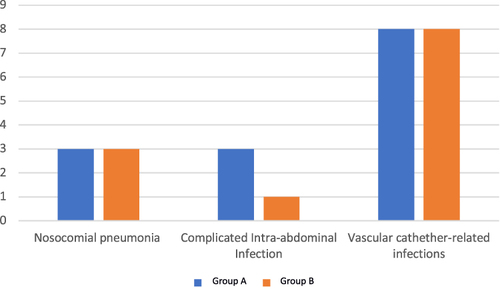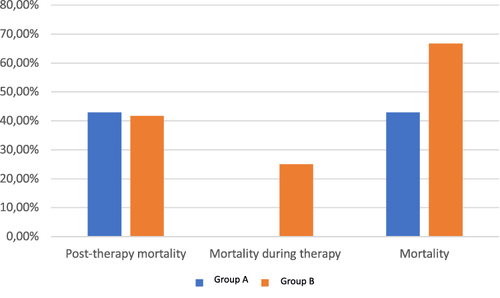Abstract
Background
The difficulties in attaining effective antibiotic therapy arising from the multidrug resistance of Gram-negative bacilli compel the exploration of new possibilities for synergistic interactions among existing antibiotics.
Research Design and Methods
An analysis was conducted to assess the efficacy of two antibiotic therapy regimens in the treatment of infections caused by Klebsiella pneumoniae strains producing carbapenemases (MBL). Two patient groups were considered: Group A – individuals in whom the treatment of infection involved the application of ceftazidime-avibactam in combination with aztreonam. Group B comprised patients subjected to an alternative antibiotic therapy regimen.
Results
In the group subjected to the treatment regimen involving ceftazidime-avibactam and aztreonam, as compared to alternative antibiotic combinations, a statistically lower mortality rate during the course of treatment and a faster clinical response to the administered therapy were evident.
Conclusion
The results obtained may be applicable to routine in vitro assays performed and serve as valuable guidance for the potential utilization of the positive effect of antibiotic therapy through the synergy between ceftazidime-avibactam and aztreonam. The selection of antibiotics employed in the therapy of invasive infections caused by K. pneumoniae influences the ultimate treatment outcome.
Introduction
Resistance to carbapenems among Gram-negative bacilli from the Enterobacterales family, as well as non-fermenting bacilli, currently constitutes a predominant challenge in the treatment of nosocomial infections. In recent years, there has been a significant increase in both the number of infections and the number of deaths caused by multidrug-resistant bacterial strains. The mortality rate in cases of infections caused by multidrug-resistant strains may be up to four times higher compared to infections caused by susceptible strains. Resistance to carbapenems is usually associated with resistance to all beta-lactam antibiotics, which significantly limits therapeutic options. This resistance may result from the production of carbapenemases, ie enzymes that degrade carbapenems and other beta-lactam antibiotics. The exception here is metal-beta-lactamases (MBLs) – class B carbapenemases, which by definition degrade all beta-lactam antibiotics except monobactams, ie aztreonam. The production of carbapenemases by bacteria is often associated with the resistance to other antibiotic groups, and this results in limited or even no therapeutic options for the treatment of infections. In the case of MBL(+), aztreonam lacks clinical activity due to the frequent additional presence of ESBLs (extended-spectrum beta-lactamases) or AmpC-type (chromosomal cephalosporinase) beta-lactamases that hydrolyze it.Citation1–5 In the treatment of infections caused by multidrug-resistant strains of Gram-negative bacilli, antibiotics with diverse mechanisms of action and targets are employed. Disparities in the pharmacokinetic-pharmacodynamic profile arise not only from differences in the molecular structure of the drug molecule. Significant factors contributing to these differences include the degree of binding to plasma proteins, half-life, interactions with other drugs, timing of administration (particularly for beta-lactam antibiotics), volume of distribution, etc.Citation6 It is crucial to explore effective therapeutic options for treating infections caused by multidrug-resistant strains as well as to develop tools for rapid identification of highly virulent strains, which could significantly reduce the risk of epidemics.Citation7
Detailed information on issues related to the diagnosis, treatment, and monitoring of infections caused by multidrug-resistant microorganisms, including MBL(+) Gram-negative bacilli, can be found in the available literature. One of the therapeutic options mentioned concerns the combination of ceftazidime-avibactam with aztreonam. This therapy is still infrequently employed, underscoring the importance of documenting and publishing experiences with the utilization of such combinations.Citation1,Citation2,Citation8 In the combination of these antibiotics, avibactam is supposed to inhibit ESBL-type and/or AmpC-type beta-lactamases, while the actual antimicrobial activity is exhibited by aztreonam (in many countries, including Poland, avibactam is available only in combination form with ceftazidime). Avibactam in isolation does not display activity against class B carbapenemases, such as NDM (New Delhi metallo-beta-lactamase). In the microbiology laboratory, it is possible to determine synergism in vitro using a diffusion method on agar medium, which may argue for the use of such a drug combination.Citation1–3,Citation9
Several in vitro methods exist to determine synergy among antibiotics. One of the methods involves preparing a Mueller-Hinton Agar plate and inoculating it with the strain for which the synergy of drugs will be assessed. Then place a blotting paper disk with the antibiotic on the plate at a suitable distance from the gradient strip with the other antibiotic. The attainment of a growth inhibition zone between the two antibiotics in the form of a “inverse D” indicates synergy between the tested drugs (see ). This is the method used in this above description.
Figure 1 The photo illustrates the identification of synergism in vitro (plate (A and B) by qualitative method on Mueller-Hinton agar medium. Visible zone of inhibition of bacterial growth in the form of “inverted letter D”. Plate (C) – no synergism. Klebsiella pneumoniae CPE (NDM+ and OXA-48) strain was spread on the agar plates (A and B), Acinetobacter baumannii strain was used to demonstrate the lack of synergism.

Materials (or Patients) and Methods
This retrospective observational study was approved by the local bioethics committee (KE-201/ 03/2024). This study was performed in adherence to the Declaration of Helsinki and Good Clinical Practice guidelines. The study was designed as a retrospective analysis based on a single-center registry. Limitations of this study include the sample size, which was small.
The analysis was conducted on 26 patients who underwent treatment in the intensive care unit from February 2021 to January 2024. The patients qualified for the study were between 41 and 72 years of age (). The reason for hospitalization in the intensive care unit was respiratory failure requiring intubation and mechanical ventilation. All eligible patients were admitted to the hospital on an emergency basis for urgent reasons and not as an aggravation of the underlying disease (gastrointestinal perforation, acute pancreatitis, multi-organ trauma). Invasive infection was diagnosed in all patients after 72 hours of hospitalization and was considered nosocomial. Patients with multiple comorbidities and exacerbation of previously diagnosed chronic diseases were excluded from the study.
Table 1 The Data of the Patients Examined
In all patients included in the analysis, invasive infection caused by Klebsiella pneumoniae producing class B carbapenemases – MBL, specifically of the NDM type, was identified. Additionally, the presence of another resistance mechanism, preventing the use of aztreonam in monotherapy (ESBL and/or AmpC), was also identified. The described cases of infections involved: thirteen cases of vascular catheter-related infections, three complicated intra-abdominal infections, and five cases of nosocomial pneumonia (see ). In both groups, the course of therapy was monitored through the assessment of clinical status and follow-up culture results obtained from the infection site (blood, bronchoaspirate, culture of fluid from the abdominal cavity). Both for ceftazidime-avibactam and aztreonam, extended infusions were administered, with 2-hour and 1-hour durations, respectively. Tigecycline was administered as a 1-hour infusion.Citation10 In the case of colistin sodium and tigecycline, a loading dose was administered. In all cases, the highest possible drug doses were utilized based on current antibiotic dosing recommendations.Citation11 The dose selection took into account the patient’s body weight, renal excretory function (creatinine clearance), the presence of edema, the use of renal replacement techniques, and the patient’s age.
The analyzed patients were divided into two groups based on the treatment regimen applied. In the first group (Group A), which included nine patients, the treatment involved the combination of ceftazidime-avibactam with aztreonam. In the second group (Group B), comprising twelve patients, an alternative antimicrobial treatment was administered, tailored to the antibiogram, and consistently as part of combination therapy. The antibiotics used in Group B included colistin sodium, fosfomycin, an aminoglycoside, and tigecycline. No severe adverse effects resulting from the administered antibiotic therapy, necessitating a change in the treatment approach, were observed in either group.
In Group A, each of the individually assessed antibiotics demonstrated resistance against the studied strain in vitro (interpreted according to the EUSAST 2023 recommendations).Citation11 Subsequently, synergy was manually determined by placing a gradient strip with aztreonam and a disk with ceftazidime-avibactam (14 micrograms) on Mueller-Hinton Agar inoculated with a suspension of Klebsiella pneumoniae at a concentration of 0.5 McFarland. The distance between the center of the disk and the center of the gradient strip was 15 mm. The disk was positioned at the Minimal Inhibitory Concentration (MIC) breakpoint value for Enterobacterales antibiotics (in this case, 4 mg/L), allowing for the overlap of the antibiotic diffusion zones. Similar determination of synergy was performed using a gradient strip with ceftazidime-avibactam and a disk with aztreonam (30 micrograms, placed at the MIC breakpoint for ceftazidime-avibactam for Enterobacterales, ie, 8 mg/L), achieving the same result, indicating in vitro synergy.Citation12 This was followed by incubation at 35 degrees for 18–24 hours. A positive result was defined by the presence of an additional growth inhibition zone between the gradient strip and the antibiotic disk in the form of a “reverse D”. This indicated the identification of synergy between the tested antibiotics in vitro (see ). In such cases, the treatment regimen was applied as in Group A.
The Student’s T-test was used as a method to check whether there was a statistically significant difference between the results in the groups. A 5% risk of error was adopted for the study, and differences were considered statistically significant for p < 0.05. Statistica 13 (StatSoft, Inc.) was used for the calculations.
Results
In the analyzed Group A, no deaths were recorded during the course of the therapy. However, four out of the nine patients treated with this regimen died during further hospitalization in the Intensive Care Unit, after completion of antimicrobial therapy. In none of the cases was septic shock or sepsis the direct cause of death, but rather secondary complications arising from the severe course of the underlying disease.
In Group B, which included twelve patients, three patients died during the therapy, namely in the course of septic shock or sepsis, constituting 25% of the examined group. On the other hand, among the patients who were identified as having successfully treated the infection, five died during the course of further hospitalization, accounting for 41.47% of all patients in this group. A total of eight patients died in Group B, accounting for 66.67%. During the combination therapy based on the synergy of ceftazidime-avibactam with aztreonam (Group A), no deaths were recorded, while the mortality during therapy in Group B was statistically significantly higher, reaching 25% (p<0.05). Thus, the overall mortality rate in group A was 44.4%, while in group B it was 66.67% (p<0.05). The mortality of patients in both groups after the completion of therapy was comparable, with rates of 44.4% in Group A and 41.67% in Group B (p>0.05) (see ).
The best treatment outcomes were achieved in the group where a combination antibiotic therapy of ceftazidime-avibactam with aztreonam was utilized.
The average treatment time for patients in Group A was 6.5 days (4–9). There were much greater discrepancies in treatment time in Group B, where the average treatment time was 8.5 days (2–15). In this group, the shortest time was for patients who, despite the treatment administered, died during therapy. After excluding patients who died during therapy, the average duration of antibiotic therapy in Group B was 11 days (ranging from 7 to 15 days). A statistically significantly shorter duration of treatment, coupled with a better clinical outcome, was observed in the group of patients in whom combination therapy of ceftazidime-avibactam with aztreonam was employed for the treatment of invasive infection caused by multidrug-resistant strains of Klebsiella pneumoniae MBL(+), NDM(+) (p<0.05).
Discussion
Synergism is a pharmacodynamic relationship between drugs characterized by an enhancement of their efficacy when used simultaneously (this relationship could be metaphorically illustrated as follows: 2+2=5. In the case of another type of relationship, namely additivity, the relationship would appear as follows: 2+2=4).
Infections caused by multidrug-resistant strains of bacteria are one of the challenges of 21st-century medicine. The widespread use of antimicrobial drugs, as well as the rapid development of virtually all fields of medicine, facilitates the dissemination of these exceptionally hazardous pathogens. The selection of appropriate therapy and its prompt implementation often holds pivotal significance for the ultimate outcome of the treatment. It appears that the application of therapy based on the synergy of ceftazidime-avibactam with aztreonam may confer an advantage over other potentially alternative treatment modalities.
The choice of antibiotic used in the treatment of invasive infections influences the mortality associated with the infection. In patients in whom the therapeutic effect of curing the infection has been achieved, the type of antibiotic used does not exhibit statistically significant impact on subsequent survival (p>0.05). From a clinical standpoint, the appropriate selection of an antimicrobial drug appears to be significant.
The correlations noted are consistent with reports by authors from other centers that focused on the comparison of ceftazidime-avibactam treatment versus other alternative antibiotic combinations.Citation13–15 However, the authors of the studies emphasize that broader investigations and additional data on such treatment regimens are necessary.Citation8,Citation15–17 It should also be noted that a delay in the initiation of targeted treatment is associated with a statistically significant increase in mortality.Citation18,Citation19
Conclusions
The use of the combination of ceftazidime-avibactam with aztreonam demonstrates good efficacy in the treatment of invasive infections caused by K. pneumoniae MBL+, NDM+. The results obtained may be applicable in determining the synergy between ceftazidime-avibactam and aztreonam, which, due to the resistance of carbapenemase-producing K. pneumoniae, would not find application in antibiotic therapy. A simple method utilizing routinely conducted susceptibility tests (antibiograms) in microbiological laboratories is readily available and enables a clear identification of the emerging synergistic effect between ceftazidime-avibactam and aztreonam. This has significant implications for its potential application in therapy. To determine synergy, a gradient strip with ceftazidime-avibactam and a disk with aztreonam (30 micrograms) or a gradient strip with aztreonam and a disk with ceftazidime-avibactam (14 micrograms) can be employed. It is essential to remember that the antibiotic disk must be placed at the appropriate height on the gradient strip.
Author Contributions
All authors made a significant contribution to the work reported, whether that is in the conception, study design, execution, acquisition of data, analysis and interpretation, or in all these areas; took part in drafting, revising or critically reviewing the article; gave final approval of the version to be published; have agreed on the journal to which the article has been submitted; and agree to be accountable for all aspects of the work.
Disclosure
The authors report no conflicts of interest in this work.
References
- Żukowska A, Hryniewicz W. Recommendations for diagnosis, therapy and antibiotic prophylaxis infections in the hospital-2020. Antybiotyki.edu.pl. Warsaw. National institute of medicines. Polish; 2023. Avaliable from: https://antybiotyki.edu.pl/wp-content/uploads/2021/03/rekomendacje-diagnostyki-terapii 2021.03.02.pdf. Accessed May 24.
- Karampatakis T, Tsergouli K, Behzadi P. Carbapenem-Resistant Klebsiella pneumoniae: virulence factors, molecular epidemiology and latest updates in treatment options. Antibiotics. 2023;12(2):234. doi:10.3390/antibiotics12020234
- Taha R, Kader O, Shawky S, et al. Ceftazidime-Avibactam plus aztreonam synergistic combination tested against carbapenem-resistant Enterobacterales characterized phenotypically and genotypically: a glimmer of hope. Ann Clin Microbiol Antimicrob. 2023;22(1):21. doi:10.1186/s12941-023-00573-3
- Nordmann P, Gniadkowski M, Giske CG, et al. European network on carbapenemases. identification and screening of carbapenemase-producing Enterobacteriaceae. Clin Microbiol Infect. 2012;18(5):432–438. doi:10.1111/j.1469-0691.2012.03815.x
- Miriagou V, Cornaglia G, Edelstein M, et al. Acquired carbapenemases in Gram-negative bacterial pathogens: detection and surveillance issues. Clin Microbiol Infect. 2010;16(2):112–122. doi:10.1111/j.1469-0691.2009.03116.x
- Swaminathan S, Routray A, Mane A. Early and appropriate use of ceftazidime-avibactam in the management of multidrug-resistant gram-negative bacterial infections in the Indian scenario. Cureus. 2022;14(8):e28283. doi:10.7759/cureus.28283
- Fasciana T, Ciammaruconi A, Gentile B, et al. draft genome sequence and biofilm production of a carbapenemase-producing Klebsiella pneumoniae (KpR405) Sequence Type 405 Strain Isolated in Italy. Antibiotics. 2021;10:560. doi:10.3390/antibiotics10050560
- Zhen S, Wang H, Feng S. Update of clinical application in ceftazidime-avibactam for multidrug-resistant Gram-negative bacteria infections. Infection. 2022;50(6):1409–1423. doi:10.1007/s15010-022-01876-x
- Isler B, Aslan AT, Akova M, et al. Treatment strategies for OXA-48-like and NDM producing Klebsiella pneumoniae infections Pneumoniae Infections. Expert Rev Anti Infect Ther. 2022;20(11):1389–1400. doi:10.1080/14787210.2022.2128764
- Xu C, Zeng F, Huang Y, et al. Clinical efficacy of ceftazidime/avibactam combination therapy for severe hospital-acquired pulmonary infections caused by carbapenem-resistant and difficult-to-treat pseudomonas aeruginosa. Int J Antimicrob Agents. 2023;25:107021. doi:10.1016/j.ijantimicag.2023.107021
- Eucast.org. The European Committee on Antimicrobial Susceptibility Testing. Breakpoint tables for interpretation of MICs and zone diameters. Version 13.1, 2023; 2023. Avaliable from: https://www.eucast.org/fileadmin/src/media/PDFs/EUCAST_files/Breakpoint_tables/v_13.1_Breakpoint_Tables.pdf. Accessed May 24, 2024.
- Khan A, Erickson SG, Pettaway C, et al. Evaluation of susceptibility testing methods for aztreonam and ceftazidime-avibactam combination therapy on extensively drug-resistant gram-negative organisms. Antimicrob Agents Chemother. 2021;65(11):e0084621. doi:10.1128/AAC.00846-21
- Castón JJ, Cano A, Pérez-Camacho I, et al. Impact of ceftazidime/avibactam versus best available therapy on mortality from infections caused by carbapenemase-producing Enterobacterales (CAVICOR study). J Antimicrob Chemother. 2022;77(5):1452–1460. doi:10.1093/jac/dkac049
- Zalas-Więcek P, Prażyńska M, Pojnar Ł, et al. Ceftazidime/avibactam and other commonly used antibiotics activity against enterobacterales and pseudomonas aeruginosa isolated in Poland in 2015–2019. Infect Drug Resist. 2022;15:1289–1304. doi:10.2147/IDR.S344165
- Chen Y, Huang HB, Peng JM, et al. Efficacy and safety of ceftazidime-avibactam for the treatment of carbapenem-resistant enterobacterales bloodstream infection: a systematic review and meta-analysis. Microbiol Spectr. 2022;10(2):e0260321. doi:10.1128/spectrum.02603-21
- Giamarellou H, Karaiskos I. Current and potential therapeutic options for infections caused by difficult-to-treat and pandrug resistant gram-negative bacteria in critically ill patients. Antibiotics. 2022;11(8):1009. doi:10.3390/antibiotics11081009
- Paul M, Carrara E, Retamar P, et al. European Society of Clinical Microbiology and Infectious Diseases (ESCMID) guidelines for the treatment of infections caused by multidrug-resistant Gram-negative bacilli (endorsed by European society of intensive care medicine). Clin Microbiol Infect. 2022;28(4):521–547. doi:10.1016/j.cmi.2021.11.025
- Bassetti M, Vena A, Giacobbe DR, et al. Management of infections caused by multidrug-resistant gram-negative pathogens: recent advances and future directions. Arch Med Res. 2021;52(8):817–827. doi:10.1016/j.arcmed.2021.09.002
- Bassetti M, Mularoni A, Giacobbe DR, et al. New antibiotics for hospital-acquired pneumonia and ventilator-associated pneumonia. Semin Respir Crit Care Med. 2022;43(2):280–294. doi:10.1055/s-0041-1740605


